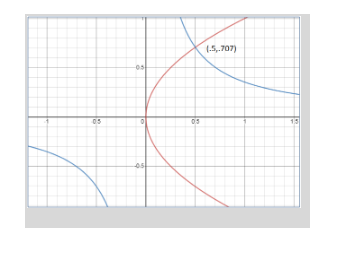Answer
424.2k+ views
Hint: Here we will try to find the values of the slopes to the curves at any point. We know that the value of the slope of the tangent to a particular point on the curve is determined by the slope of the tangent at the point. The slope of the tangent to the curve is determined by differentiation. If two curves cut each other orthogonally then the tangents also intersect at right angles (orthogonally.).Then use the fact that the product of the slopes of two lines that intersect orthogonally is -1. \[\]
Complete step-by-step answer:
The given equations of the curves are
\begin{align*}
& x={{y}^{2}}.........\left( 1 \right) \\
& xy={{a}^{3}}........\left( 2 \right)
\end{align*}
Putting value of $ x $ form the equation (1) in equation (2),
\[\begin{align}
& y\cdot {{y}^{2}}={{y}^{3}}={{a}^{3}} \\
& \Rightarrow y=a \\
& \therefore x={{y}^{2}}={{a}^{2}} \\
\end{align}\]
So the coordinates of the point of intersection are $ \left( {{a}^{2}},a \right) $ .
Now we will determine the value of slope of tangent to the curve at $ \left( {{a}^{2}},a \right) $ from equation (1),
\[\begin{align}
& x={{y}^{2}} \\
& \Rightarrow \dfrac{dx}{dx}=2y\dfrac{dy}{dx}\text{ }\left( \text{differentiating bothside wrt }x \right) \\
& \Rightarrow \dfrac{dy}{dx}=\dfrac{1}{2y} \\
\end{align}\]
So the slope at $ \left( {{a}^{2}},a \right) $ is $ \dfrac{1}{2y}=\dfrac{1}{2a}={{m}_{1}}\left( \text{say} \right). $ \[\]
Similarly the value of the slope of the tangent to the curve at $ \left( {{a}^{2}},a \right) $ in equation (2),
\[\begin{align}
& \text{ }xy={{a}^{3}} \\
& \Rightarrow \dfrac{d}{dx}\left( xy \right)=0\left( \text{differentiating bothside wrt }x \right) \\
& \Rightarrow x\dfrac{dy}{dx}+y\dfrac{dx}{dx}=0 \\
& \Rightarrow \dfrac{dy}{dx}=-\dfrac{y}{x} \\
\end{align}\]
So the slope at $ \left( {{a}^{2}},a \right) $ is $ \dfrac{-y}{x}=\dfrac{-a}{{{a}^{2}}}=-\dfrac{1}{2}={{m}_{2}}\left( \text{say} \right) $ \[\]
If two curves cut orthogonally then the product of their slopes of the tangents at the point of intersection is -1.
\[\begin{align}
& \therefore {{m}_{1}}{{m}_{2}}=-1 \\
& \Rightarrow \dfrac{1}{2a}\cdot \left( \dfrac{-1}{a} \right)=-1 \\
& \Rightarrow \dfrac{1}{2}={{a}^{2}} \\
\end{align}\]
So the only correct option is (D) $ \dfrac{1}{2} $ . We can verify this by plotting the curves taking $ {{a}^{2}}=\dfrac{1}{\sqrt{2}} $ and observe that the point of intersection is $ \left( {{a}^{2}},a \right)=\left( \dfrac{1}{2},\dfrac{1}{\sqrt{2}} \right) $ .
So, the correct answer is “Option D”.

Note: The question tests your knowledge of implicit differentiation and tangent of the curves. Be careful when you differentiate $ x={{y}^{2}} $ , because if you go the route of direct differentiation and take square root on both sides that will give you two results.
Complete step-by-step answer:
The given equations of the curves are
\begin{align*}
& x={{y}^{2}}.........\left( 1 \right) \\
& xy={{a}^{3}}........\left( 2 \right)
\end{align*}
Putting value of $ x $ form the equation (1) in equation (2),
\[\begin{align}
& y\cdot {{y}^{2}}={{y}^{3}}={{a}^{3}} \\
& \Rightarrow y=a \\
& \therefore x={{y}^{2}}={{a}^{2}} \\
\end{align}\]
So the coordinates of the point of intersection are $ \left( {{a}^{2}},a \right) $ .
Now we will determine the value of slope of tangent to the curve at $ \left( {{a}^{2}},a \right) $ from equation (1),
\[\begin{align}
& x={{y}^{2}} \\
& \Rightarrow \dfrac{dx}{dx}=2y\dfrac{dy}{dx}\text{ }\left( \text{differentiating bothside wrt }x \right) \\
& \Rightarrow \dfrac{dy}{dx}=\dfrac{1}{2y} \\
\end{align}\]
So the slope at $ \left( {{a}^{2}},a \right) $ is $ \dfrac{1}{2y}=\dfrac{1}{2a}={{m}_{1}}\left( \text{say} \right). $ \[\]
Similarly the value of the slope of the tangent to the curve at $ \left( {{a}^{2}},a \right) $ in equation (2),
\[\begin{align}
& \text{ }xy={{a}^{3}} \\
& \Rightarrow \dfrac{d}{dx}\left( xy \right)=0\left( \text{differentiating bothside wrt }x \right) \\
& \Rightarrow x\dfrac{dy}{dx}+y\dfrac{dx}{dx}=0 \\
& \Rightarrow \dfrac{dy}{dx}=-\dfrac{y}{x} \\
\end{align}\]
So the slope at $ \left( {{a}^{2}},a \right) $ is $ \dfrac{-y}{x}=\dfrac{-a}{{{a}^{2}}}=-\dfrac{1}{2}={{m}_{2}}\left( \text{say} \right) $ \[\]
If two curves cut orthogonally then the product of their slopes of the tangents at the point of intersection is -1.
\[\begin{align}
& \therefore {{m}_{1}}{{m}_{2}}=-1 \\
& \Rightarrow \dfrac{1}{2a}\cdot \left( \dfrac{-1}{a} \right)=-1 \\
& \Rightarrow \dfrac{1}{2}={{a}^{2}} \\
\end{align}\]
So the only correct option is (D) $ \dfrac{1}{2} $ . We can verify this by plotting the curves taking $ {{a}^{2}}=\dfrac{1}{\sqrt{2}} $ and observe that the point of intersection is $ \left( {{a}^{2}},a \right)=\left( \dfrac{1}{2},\dfrac{1}{\sqrt{2}} \right) $ .
So, the correct answer is “Option D”.

Note: The question tests your knowledge of implicit differentiation and tangent of the curves. Be careful when you differentiate $ x={{y}^{2}} $ , because if you go the route of direct differentiation and take square root on both sides that will give you two results.
Recently Updated Pages
How many sigma and pi bonds are present in HCequiv class 11 chemistry CBSE

Why Are Noble Gases NonReactive class 11 chemistry CBSE

Let X and Y be the sets of all positive divisors of class 11 maths CBSE

Let x and y be 2 real numbers which satisfy the equations class 11 maths CBSE

Let x 4log 2sqrt 9k 1 + 7 and y dfrac132log 2sqrt5 class 11 maths CBSE

Let x22ax+b20 and x22bx+a20 be two equations Then the class 11 maths CBSE

Trending doubts
Fill the blanks with the suitable prepositions 1 The class 9 english CBSE

At which age domestication of animals started A Neolithic class 11 social science CBSE

Which are the Top 10 Largest Countries of the World?

Give 10 examples for herbs , shrubs , climbers , creepers

Difference between Prokaryotic cell and Eukaryotic class 11 biology CBSE

Difference Between Plant Cell and Animal Cell

Write a letter to the principal requesting him to grant class 10 english CBSE

Change the following sentences into negative and interrogative class 10 english CBSE

Fill in the blanks A 1 lakh ten thousand B 1 million class 9 maths CBSE



